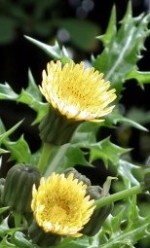 A native of Europe, spiny sow thistle is a common annual weed throughout the United States. It thrives in sun and can be found in gardens, lawns, pastures, and waste areas such as roadsides. Seeds germinate in spring or fall and the plant sometimes acts as a biennial. In spite of the common name “thistle” sow thistle is not a thistle and its flowers resemble those of a dandelion.
A native of Europe, spiny sow thistle is a common annual weed throughout the United States. It thrives in sun and can be found in gardens, lawns, pastures, and waste areas such as roadsides. Seeds germinate in spring or fall and the plant sometimes acts as a biennial. In spite of the common name “thistle” sow thistle is not a thistle and its flowers resemble those of a dandelion.
 Description: Growing from a long taproot, a rosette of leaves emerge first followed by a single leafy unbranched stem that is 2-6’ tall. The weak stem is hollow and when broken exudes a milky sap. The bluish-green leaves are 2½”- 12” long, ½”-6” wide, deeply cut, and have prickly margins that can irritate the skin. Rounded lobes attach the leaves to the stem as they decrease in size upward. Flower heads ½”-1” wide are produced in clusters from spring until fall and are composed only of yellow ray flowers, like a dandelion. The seeds have fluffy white attachments like those of dandelion that facilitate dispersal by wind.
Description: Growing from a long taproot, a rosette of leaves emerge first followed by a single leafy unbranched stem that is 2-6’ tall. The weak stem is hollow and when broken exudes a milky sap. The bluish-green leaves are 2½”- 12” long, ½”-6” wide, deeply cut, and have prickly margins that can irritate the skin. Rounded lobes attach the leaves to the stem as they decrease in size upward. Flower heads ½”-1” wide are produced in clusters from spring until fall and are composed only of yellow ray flowers, like a dandelion. The seeds have fluffy white attachments like those of dandelion that facilitate dispersal by wind.

 Control: Spiny sow thistle can be hoed up, or hand pulled but the taproot and weak stem usually usually result in only the top of the plant being removed. The taproot then usually sends up another rosette . Removing the tops of the plants before they produce flowers and go to seed, however, prevents further spread of the weed. Tops can also be removed by hand cutting or mowing. Some herbicides give good control.
Control: Spiny sow thistle can be hoed up, or hand pulled but the taproot and weak stem usually usually result in only the top of the plant being removed. The taproot then usually sends up another rosette . Removing the tops of the plants before they produce flowers and go to seed, however, prevents further spread of the weed. Tops can also be removed by hand cutting or mowing. Some herbicides give good control.